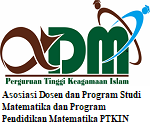Rarity of Joint Probability Between Interest and Inflation Rates in the 1998 Economic Crisis in Indonesia and Their Comparison Over Three Time Periods
DOI:
https://doi.org/10.15642/mantik.2022.8.1.10-17Keywords:
Copula, Economic crisis, Inflation rate, Interest rate, Joint return period, UncertaintyAbstract
After more than twenty years, there has been no economic crisis as severe as 1998 based on inflation and interest rates. It is interesting to compare the conditions before and after the 1998 crisis and the economic conditions in the last decade in Indonesia. Therefore, this study aims to analyze the relationship between inflation and interest rates using a copula-based joint distribution. The joint return period of the 1998 economic crisis is estimated from this joint distribution. The results showed that the Gumbel copula is the most suitable bivariate copula to construct a joint distribution between inflation and interest rates in 1990-2019, with an upper tail dependency of 0.6224. Moreover, the joint return period between inflation and interest rates more severe than 1998 is 389 years with a 95% confidence interval of [47, ∞] years. This result is uncertain because many factors affect inflation and interest rates. The inflation rate decreased after the 1998 crisis. Meanwhile, in the last decade, the inflation and interest rates were much lower than in the two previous periods.
Downloads
References
T. T. H. Tambunan, “The Indonesian Experience with Two Big Economic Crises,” Mod. Econ., vol. 01, no. 03, pp. 156–167, 2010, doi: 10.4236/me.2010.13018.
P. R. Fallon and R. E. B. Lucas, “The impact of financial crises on labor markets, household incomes, and poverty: A review of evidence,” World Bank Res. Obs., vol. 17, no. 1, pp. 21–45, 2002, doi: 10.1093/wbro/17.1.21.
H. Waters, F. Saadah, and M. Pradhan, “The impact of the 1997-98 East Asian economic crisis on health and health care in Indonesia,” Health Policy Plan., vol. 18, no. 2, pp. 172–181, 2003, doi: 10.1093/heapol/czg022.
T. Susmonowati, “Economic Value Added (EVA) Sebagai Pengukuran Kinerja Keuangan Pada Industri Telekomunikasi Suatu Analisis Empirik,” Transparansi J. Ilm. Ilmu Adm., vol. 1, no. 1, pp. 101–119, 2018, doi: 10.31334/trans.v1i1.142.
Y. R. Liu, Y. P. Li, Y. Ma, Q. M. Jia, and Y. Y. Su, “Development of a Bayesian-copula-based frequency analysis method for hydrological risk assessment –
The Naryn River in Central Asia,” J. Hydrol., vol. 580, 2020, doi: 10.1016/j.jhydrol.2019.124349.
M. K. Najib, S. Nurdiati, and A. Sopaheluwakan, “Copula based joint distribution analysis of the ENSO effect on the drought indicators over Borneo fire-prone
areas,” Model. Earth Syst. Environ., vol. 8, no. 2, pp. 2817–2826, 2022, doi: 10.1007/s40808-021-01267-5.
M. K. Najib, S. Nurdiati, and A. Sopaheluwakan, “Multivariate Fire Risk Models Using Copula Regression in Kalimantan, Indonesia,” Nat. Hazards, 2022, doi: 10.1007/s11069-022-05346-3.
M. H. Afshar, A. U. Sorman, and M. T. Yilmaz, “Conditional copula-based spatial-temporal drought characteristics analysis-A case study over Turkey,” Water (Switzerland), vol. 8, no. 10, 2016, doi: 10.3390/w8100426.
J. Zscheischler and E. M. Fischer, “The record-breaking compound hot and dry 2018 growing season in Germany,” Weather Clim. Extrem., vol. 29, 2020, doi: 10.1016/j.wace.2020.100270.
M. Sklar, “Fonctions de Répartition àn Dimensions et Leurs Marges,” Publ. L’Institut Stat. L’Université Paris, vol. 8, pp. 229–231, 1959.
C. Schölzel and P. Friederichs, “Multivariate non-normally distributed random variables in climate research - Introduction to the copula approach,” Nonlinear Process. Geophys., vol. 15, no. 5, pp. 761–772, 2008, doi: 10.5194/npg-15-761-2008.
H. Joe, Multivariate models and multivariate dependence concepts. London: CRC Press, 1997.
S. Ly, K.-H. Pho, S. Ly, and W.-K. Wong, “Determining Distribution for the Product of Random Variables by Using Copulas,” SSRN Electron. J., 2019, doi: 10.2139/ssrn.3430862.
K. Jin, K. Son, and G. Heo, “Copula-based common cause failure models with Bayesian inferences,” Nucl. Eng. Technol., vol. 53, no. 2, pp. 357–367, 2021, doi: 10.1016/j.net.2020.08.014.
Z. Hao and V. P. Singh, “Review of dependence modeling in hydrology and
water resources,” Prog. Phys. Geogr., vol. 40, no. 4, pp. 549–578, 2016, doi: 10.1177/0309133316632460.
M. K. Najib, S. Nurdiati, and A. Sopaheluwakan, “Quantifying the joint distribution of drought indicators in Borneo fire-prone area,” IOP Conf. Ser. Earth Environ. Sci., vol. 880, no. 1, p. 012002, 2021, doi: 10.1088/1755-1315/880/1/012002.
A. Buike, “Copula Modeling for World’s Biggest Competitors,” Ph.D. Dissertation, Universiteit van Amsterdam, 2018.
H. Joe, “Asymptotic efficiency of the two-stage estimation method for copula-based models,” J. Multivar. Anal., vol. 94, no. 2, pp. 401–419, 2005, doi: 10.1016/j.jmva.2004.06.003.
X. Wei, H. Zhang, V. P. Singh, C. Dang, S. Shao, and Y. Wu, “Coincidence probability of streamflow in water resources area, water receiving area and impacted area: Implications for water supply risk and potential impact of
water transfer,” Hydrol. Res., vol. 51, no. 5, pp. 1120–1135, 2020, doi: 10.2166/nh.2020.106.
M. N. Tahroudi, Y. Ramezani, C. De Michele, and R. Mirabbasi, “Analyzing the conditional behavior of rainfall deficiency and groundwater level deficiency signatures by using copula functions,” Hydrol. Res., vol. 51, no. 6, pp. 1332–1348, 2020, doi: 10.2166/nh.2020.036.
I. Pobočíková, Z. Sedliačková, and M. Michalková, “Application of Four Probability Distributions for Wind Speed Modeling,” Procedia Eng., vol. 192, pp. 713–718, 2017, doi: 10.1016/j.proeng.2017.06.123.
M. Farooq, M. Shafique, and M. S. Khattak, “Flood frequency analysis of river swat using Log Pearson type 3, Generalized Extreme Value, Normal, and Gumbel Max distribution methods,” Arab. J. Geosci., vol. 11, no. 9, 2018, doi: 10.1007/s12517-018-3553-z.
S. Baran, P. Szokol, and M. Szabó, “Truncated generalized extreme value distribution-based ensemble model output statistics model for calibration
of wind speed ensemble forecasts,” Environmetrics, vol. 32, no. 6, 2021, doi: 10.1002/env.2678.
T. W. Anderson, “Anderson–Darling Tests of Goodness-of-Fit,” in International Encyclopedia of Statistical Science, Berlin, Heidelberg: Springer, 2011, pp. 52–54.
E. Bouyé, V. Durrleman, A. Nikeghbali, G. Riboulet, and T. Roncalli,
Copulas for Finance - A Reading Guide and Some Applications. https://dx.doi.org/10.2139/ssrn.1032533, 2000.
M. H. Afshar, A. Ü. Şorman, F. Tosunoğlu, B. Bulut, M. T. Yilmaz, and A. Danandeh Mehr, “Climate change impact assessment on mild and extreme drought events using copulas over Ankara, Turkey,” Theor. Appl. Climatol., vol. 141, no. 3–4, pp. 1045–1055, 2020, doi: 10.1007/s00704-020-03257-6.
R. Link, T. B. Wild, A. C. Snyder, M. I. Hejazi, and C. R. Vernon, “100 Years of Data Is Not Enough To Establish Reliable Drought Thresholds,” J. Hydrol. X, vol. 7, 2020, doi: 10.1016/j.hydroa.2020.100052.
Downloads
Published
How to Cite
Issue
Section
License
Copyright (c) 2022 Mohamad Khoirun Najib, Sri Nurdiati, Faiqul Fikri

This work is licensed under a Creative Commons Attribution-NonCommercial-ShareAlike 4.0 International License.
- Authors retain copyright and grant the journal right of first publication with the work simultaneously licensed under a Creative Commons License that allows others to share the work with an acknowledgment of the work's authorship and initial publication in this journal.
- Authors are able to enter into separate, additional contractual arrangements for the non-exclusive distribution of the journal's published version of the work (e.g., post it to an institutional repository or publish it in a book), with an acknowledgment of its initial publication in this journal.
- Authors are permitted and encouraged to post their work online (e.g., in institutional repositories or on their website) prior to and during the submission process, as it can lead to productive exchanges, as well as earlier and greater citation of published work







.png)




